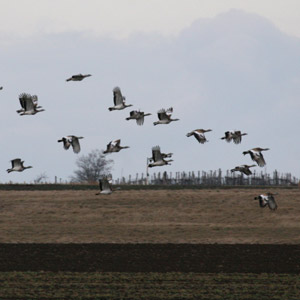Magazine | Voyages
Trois bons secteurs pour observer les oiseaux dans les plaines slovaques

Grandes Outardes (Otis tarda) en hiver dans la Syslovské polia.
Photographie : Jozef Chavko (RPS)
Introduction
La Slovaquie est un pays essentiellement montagneux, les deux tiers de sa surface étant occupés par le massif des Carpates. Le reste du territoire est constitué de plaines, (dont le vaste bassin pannonien), autrefois en partie couvertes de steppes. Aujourd’hui, elles ont été converties en zones cultivées. C’est dans ce milieu pourtant largement anthropisé qu’il est encore possible d’observer des oiseaux typiques des steppes d’Europe orientale comme la Grande Outarde, le Faucon sacre, le Faucon kobez ou l’Aigle impérial.
Nous vous présentons trois secteurs particulièrement intéressants : la Košická kotlina (ou bassin de Košice) au sud-est du pays, les environs du château de Turna (Turna nad Bodvou) situé un peu à l’ouest, et la Syslovské polia, une zone de cultures à l’extrémité sud-ouest de la Slovaquie, près des frontières autrichienne et hongroise.
Nous remercions Jozef Chavko pour ses photos.
Abstract
Slovakia is mainly a mountainous country, the Carpathian Mountains occupying the two-thirds of its surface. The Pannonian Plain covers the rest of the country. Steppes and flooded forests (notably along the Danube and Hornád rivers) were typical habitats of the slovakian plains and basins, but they consist now of open agricultural lands with thin lines of windbreak vegetation. Some areas are still nesting and wintering grounds of typical steppe species such as Imperial Eagle, Saker and Red-footed Falcons and Great Bustard. This is the case of the Košická kotlina, around the town of Košice in the south-east of the country, the area around the Turna Hill (Turna nad Bodvou) and the Syslovské polia, in the south-western part of the country, on the borders of Slovakia, Austria and Hungary.
Poursuivez la lecture de cet article, en vous abonnant dès maintenant !
Découvrez les Archives d’Ornithomedia.com
Pour seulement 10,00 €TTC/an (ou 6,00 € les 6 mois)
Profitez de plusieurs centaines d’articles en accès illimité et sans aucun engagement.
Compléments
Contact
Pour en savoir plus sur l’étude et la protection de l’Aigle impérial en Slovaquie et pour participer à des sorties ornithologiques, visitez le site web de l’association Raptor Protection of Slovakia : www.dravce.sk
Ouvrages recommandés
- Le guide Ornitho Killian Mullarney
- Slovaquie Euro Cartes de Marco Polo (2006)
- Le Petit Futé Slovaquie Dominique Auzias, Jean-Paul Labourdette, Collectif
Sources
- Natura 2000 (2008). Management of Natura 2000 habitats : Pannonic sand steppes. European Commission. http://ec.europa.eu
- Watching.sk. IBAs in Slovakia. http://www.watching.sk/about-iba/iba-in-slovakia/
- Otis tarda Rusovce. http://www.otistarda.sk/site/index.php
- Jerzy Dyczkowski, Pawel Brzek (2008). Imperial Eagles in Slovakia, 10-15.08.2001, Jerzy Dyczkowski. Birdtours.co.uk. http://www.birdtours.co.uk/tripreports/slovakia/slov1/slov2001.htm
- Honeyguide. Discover Slovakia 26 May – 2 June 2001. http://www.honeyguide.co.uk/pdfs/slovakia2001.pdf
- Jozef CHAVKO, Štefan DANKO, Ján OBUCH & Jozef MIHÓK (2007). The Food of the Imperial Eagle (Aquila heliaca) in Slovakia. Slovak Raptor Journal 1: 1 – 18. Raptor Protection of Slovakia (RPS). http://www.dravce.eu.sk/page/images/stories/slovak-raptor-journal/SRJ_2007_1_001_018.pdf
- Natura 2000. Conservation of Saker (Falco cherrug) in the Carpathian Basin (LIFE06 NAT/HU/000096). http://www.sakerlife.mme.hu/en/content/show




Aucun commentaire sur ce sujet
Participer à la discussion !